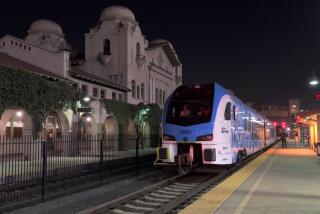Riding the Rails : A HISTORICAL LOOK AT VALLEY TRAIN TRAVEL
Seven years after the transcontinental railroad spike was driven in Utah, another Golden Spike was driven at Lang, signaling the completion of a Los Angeles-to-San Francisco route. In the late 1930s, the train traveling those tracks through the San Fernando, Santa Clarita and Antelope valleys was known as the San Joaquin Daylight. The Palmdale-Colton cutoff was established in 1967, taking trains through the Cajon Pass. This sharply reduced train traffic through Soledad Canyon, forcing the closure of several stops between Lancaster and Burbank. In 1971, Amtrak took over passenger trains and travel was ceased between Burbank and Lancaster. Today, passengers are again riding this part of the route, but for commuting rather than long-distance travel. The Burbank to Lancaster section is now owned by Metrolink, which carries commuters from the Antelope Valley to Los Angeles.
1909 Train Route
1) Lancaster: In steam-engine days, trains would often get water at this depot. Metrolinkâs first passengers in 1994 boarded on the same site as Southern Pacificâs last passengers in 1971.
2) Palmdale: At the turn of the century, crews of helper engines needed to push trains over Vincent grade to the south were based here. In the days before air-conditioning, crews tending engines dug holes in the ground to beat the heat. The station was closed in 1958, but reopened as a train order office in 1967.
3) Harold: Located here is a siding, a short railroad track connected with a main track by a switch and used for unloading and for trains to pass each other. It was built in the late 19th Century. Harold is also the site of Southern Pacific wells.
4) Vincent: An early telegraph office was established here with the opening of the Palmdale-Colton cutoff. Metrolinkâs Vincent Hill/Acton station is located on the same site.
5) Ravena: Yucca draconis, a hardy cactus used in making bank note paper, was shipped from this station in the late 1870s. After the Santa Clara River swept over the tracks in 1886, the railroad was moved to higher ground and the station, was about a mile to the west. It had a telegraph office and was an important water stop. Closed in 1960.
6) Lang: Site of the âGolden Spikeâ driving in 1876, this train order office was closed in 1967.
7) Saugus: Busy station and telegraph office that was the dividing point between the San Joaquin and Los Angeles divisions. The preserved depot has been moved to William S. Hart Park in Newhall.
8) Tunnel: Work started on March 27, 1875. Four thousand men, mostly Chinese, worked day and night on the tunnel that eventually measured 6,966 feet--more than a mile--in length. Today, the south end of the tunnel is obscured by the Golden State and Antelope Valley freeway interchange.
9) San Fernando: Depot heavily used by the citrus industry.
10) Burbank: Important junction between the Coast and Valley lines.
***
âWe entered the tunnel and in a moment knew what impenetrable gloom was. The blackness of darkness enveloped the crowd and hilarity of a moment before gave way to awe-struck whispers. . . . Emerging into the sunlight once more, after a 10-minute sojourn in the tunnel, the normal cheerfulness of the crowd was resumed. Speeding onward we passed the Santa Clara Valley, and Newhall Station, and emerged into the forbidding regions beyond.â
--Los Angeles Daily Star account of inaugural trip through the tunnel between Newhall and San Fernando on Sept. 5, 1876.
Today, it takes Metrolink passengers two minutes to make the tunnel passage.
Sources: Larry Wines and âTehachapiâ by John R. Signor, Board of Trade 1909 railroad map
Researched by STEPHANIE STASSEL / Los Angeles Times
More to Read
Sign up for Essential California
The most important California stories and recommendations in your inbox every morning.
You may occasionally receive promotional content from the Los Angeles Times.










